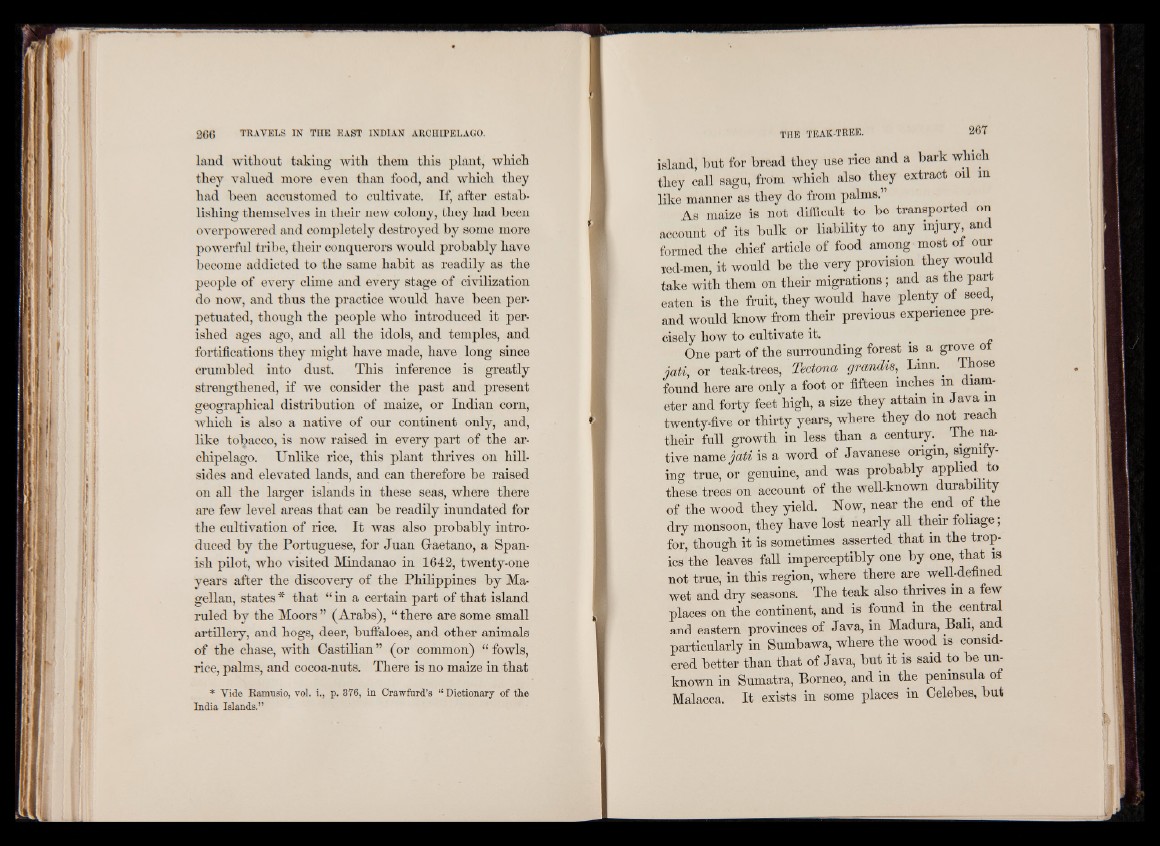
land without taking with them this plant, which
they valued more even than food, and which they
had been accustomed to cultivate. If, after establishing
themselves in their new colony, they had been
overpowered and completely destroyed by some more
powerful tribe, their conquerors would probably have
become addicted to the same habit as readily as the
people of every clime and every stage of civilization
do now, and thus the practice would have been perpetuated,
though the people who introduced it perished
ages ago, and all the idols, and temples, and
fortifications they might have made, have long since
crumbled into dust. This inference is greatly
strengthened, if we consider the past and present
geographical distribution of maize, or Indian corn,
which is also a native of our continent only, and,
like tobacco, is now raised in every part of the archipelago.
Unlike rice, this plant thrives on hillsides
and elevated lands, and can therefore be raised
on all the larger islands in these seas, where there
are few level areas that can be readily inundated for
the cultivation of rice. I t was also probably introduced
by the Portuguese, for Juan Gaetano, a Spanish
pilot, who visited Mindanao in 1642, twenty-one
years after the discovery of the Philippines by Magellan,
states * that “ in a certain part of that island
ruled by the Moors ” (Arabs), “ there are some small
artillery, and hogs, deer, buffaloes, and other animals
of the chase, with Castilian ” (or common) “ fowls,
rice, palms, and cocoa-nuts. There is no maize in that
* Yide Kamusio, vol. i., p. 376, in Crawfurd’s “Dictionary of the
India Islands.”
island, but for bread they use rice and a bark which
they call sagu, from which also they extract oil m
like manner as they do from palms.”
As maize is not difficult to be transported on
account of its bulk or liability to any injury and
formed the chief article of food among most of our
red-men, it would be the very provision they would
take with them on their migrations; and as the part
eaten is the fruit, they would have plenty of seed,
and would know from their previous experience precisely
how to cultivate it. H
One part of the surrounding forest is a grove of
jati or teak-trees, Tectona grcmdis, Lmn.^ Those
found here are only a foot or fifteen inches m diameter
and forty feet high, a size they attain in Java in
twenty-five or thirty years, where they do not reach
their full growth in less than a century. The nar
tive name ja ti is a word of Javanese origin, signifying
true, or genuine, and was probably applied to
these trees on account of the well-known durability
of the wood they yield. Now, near the end of the
dry monsoon, they have lost nearly all their foliage,
for, though it is sometimes asserted that in the tropics
the leaves fall imperceptibly one by one, that is
not true, in this region, where there are well-defined
wet and dry seasons. The teak also thrives in a few
places on the continent, and is found in the central
and eastern provinces of Java, in Madura, Bali, and
particularly in Sumbawa, where the wood is considered
better than that of Java, but it is said to be unknown
in Sumatra, Borneo, and in the peninsula of
Malacca. It exists in some places in Celebes, but